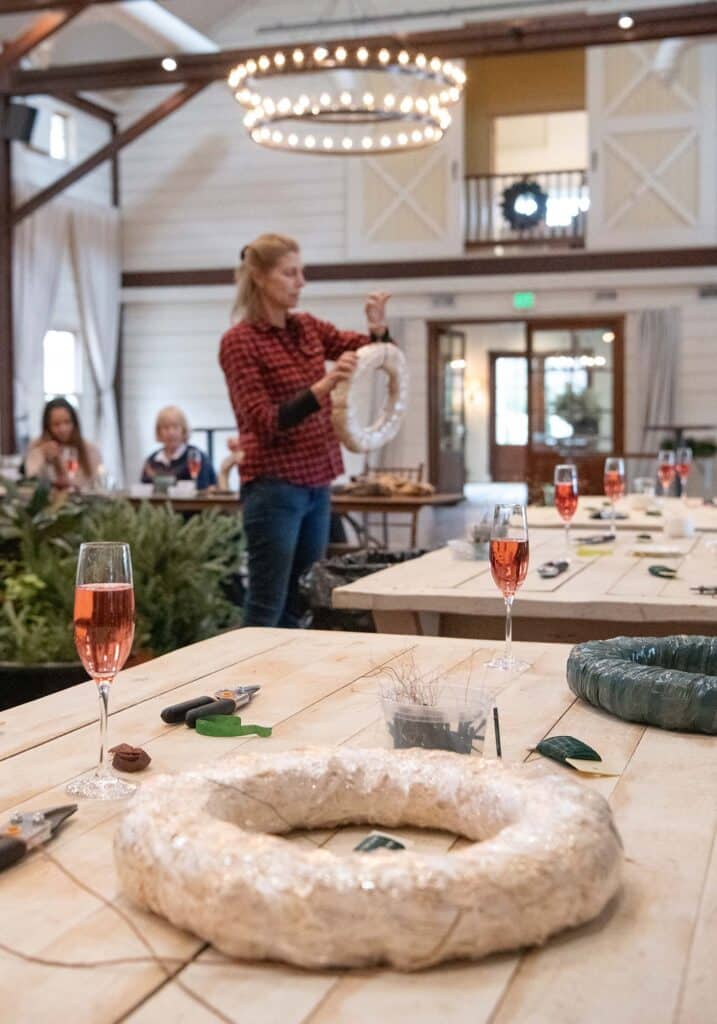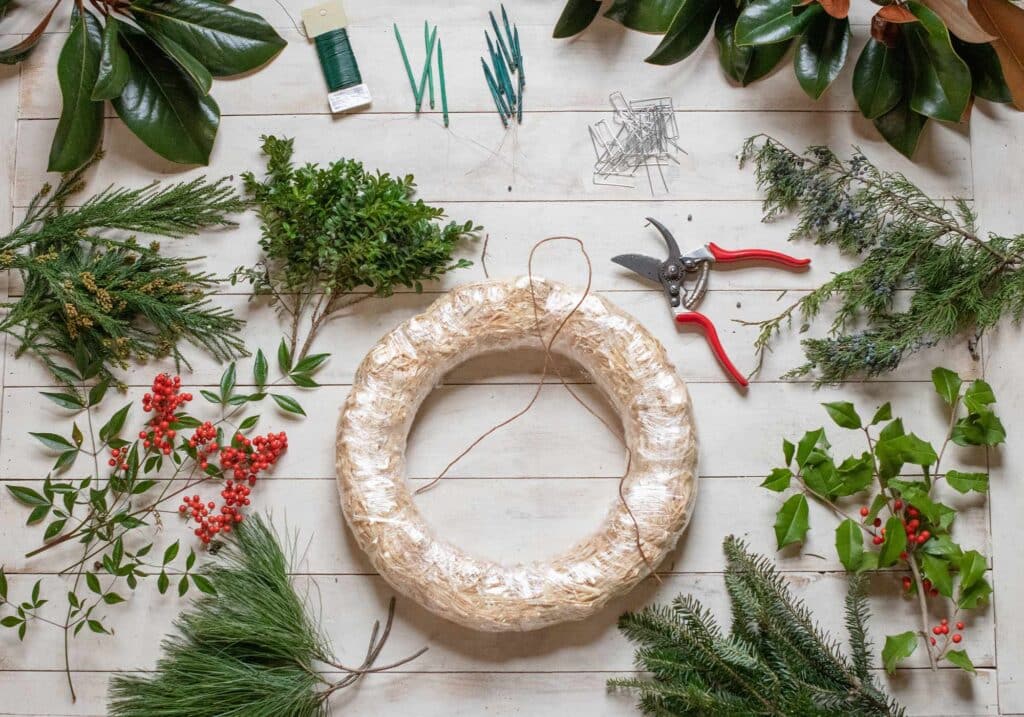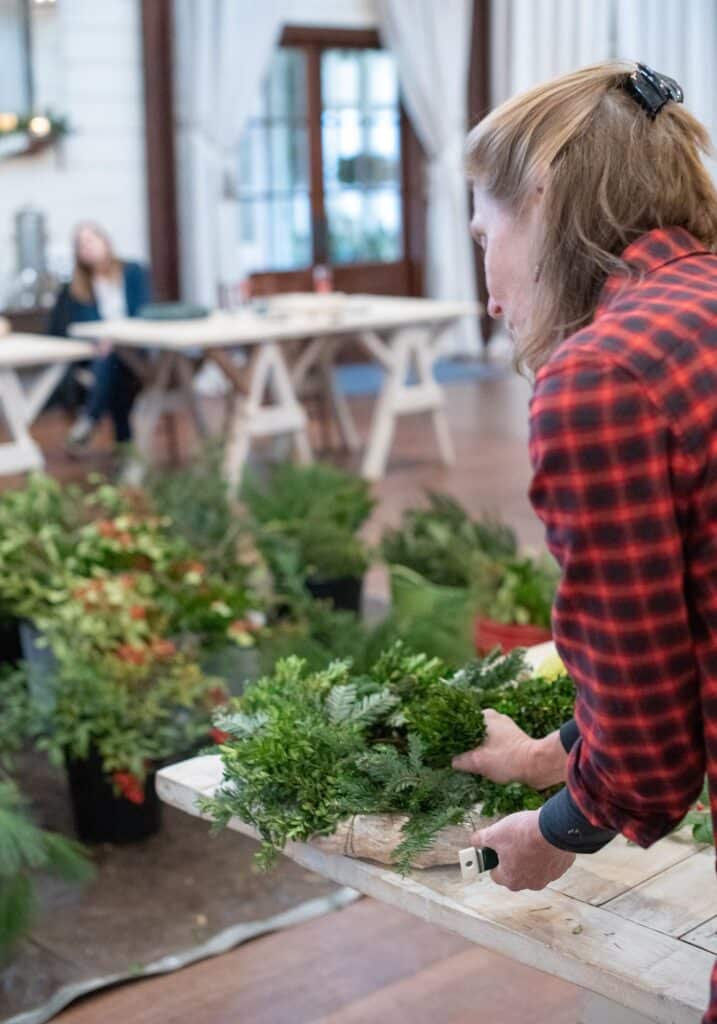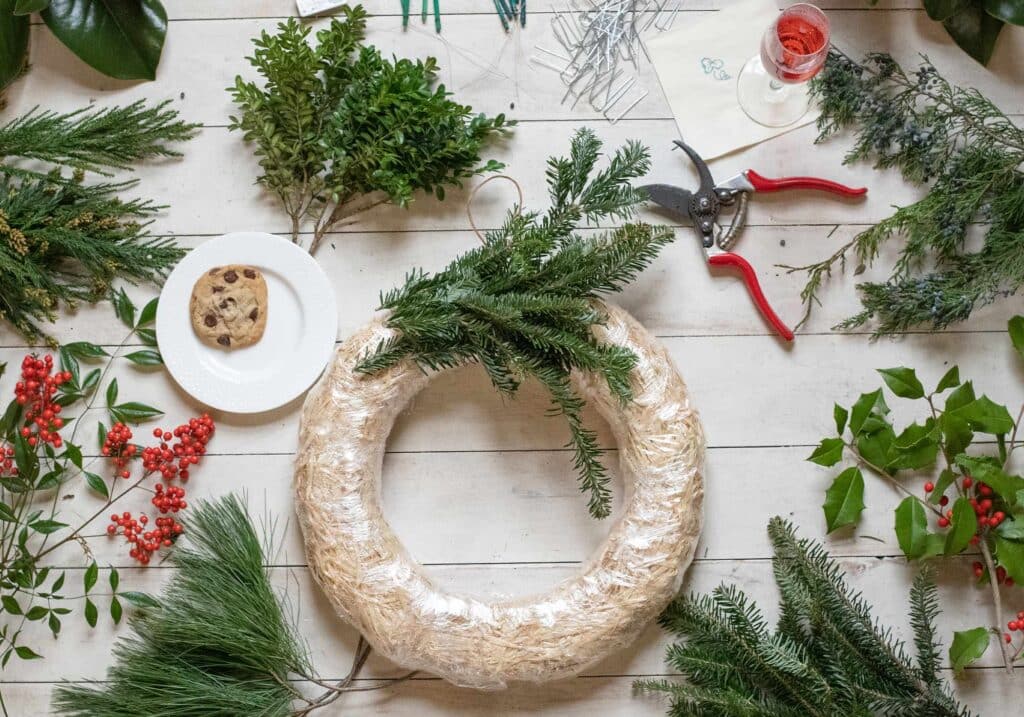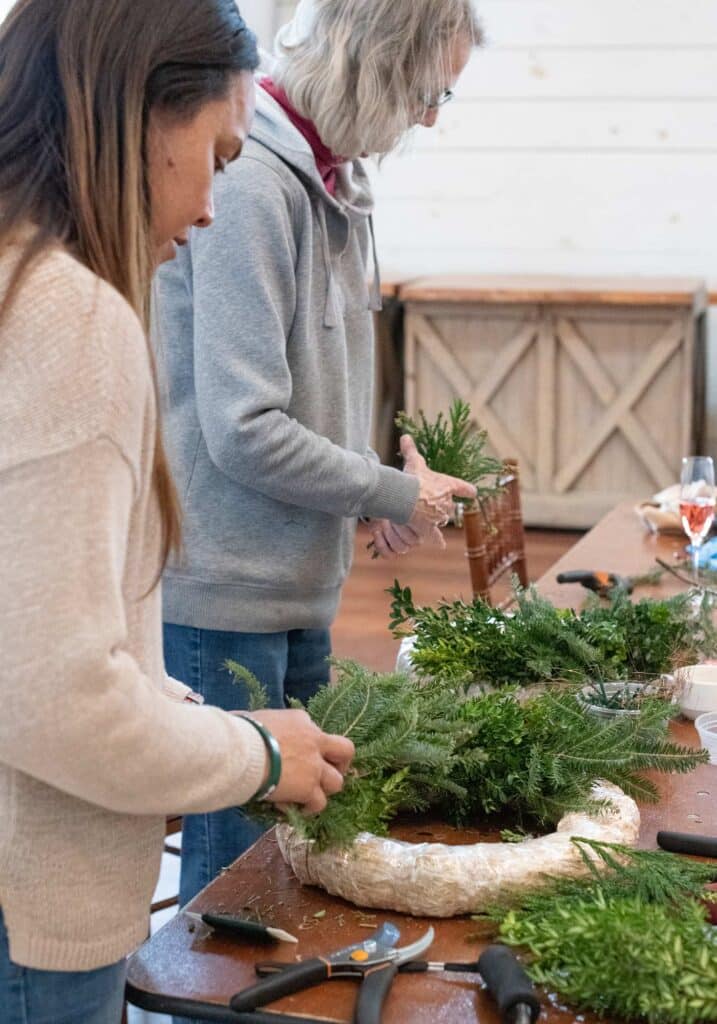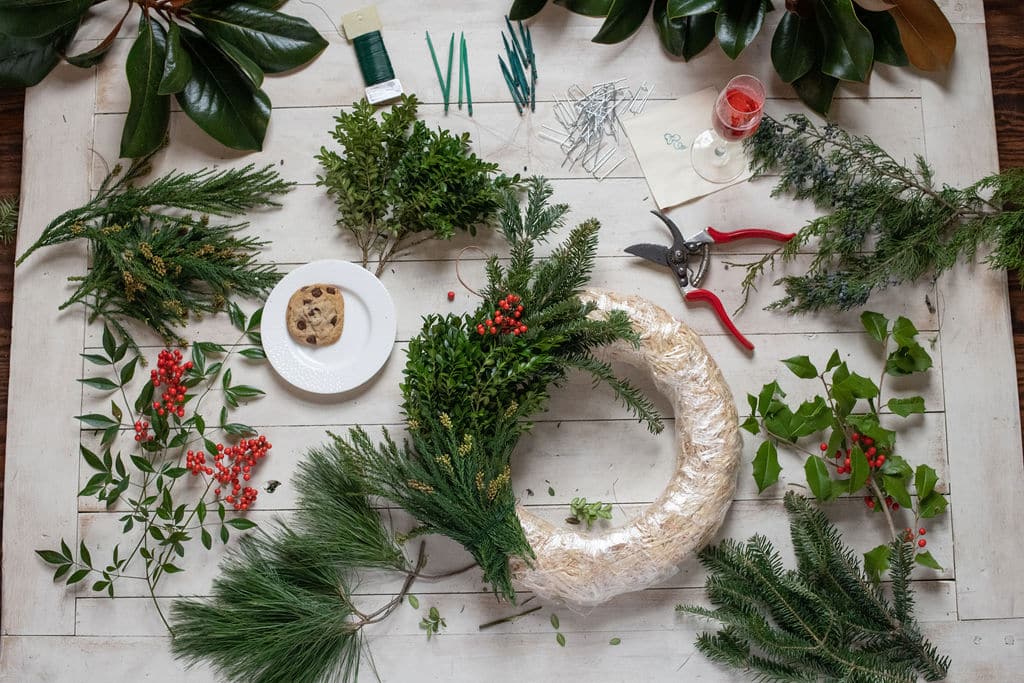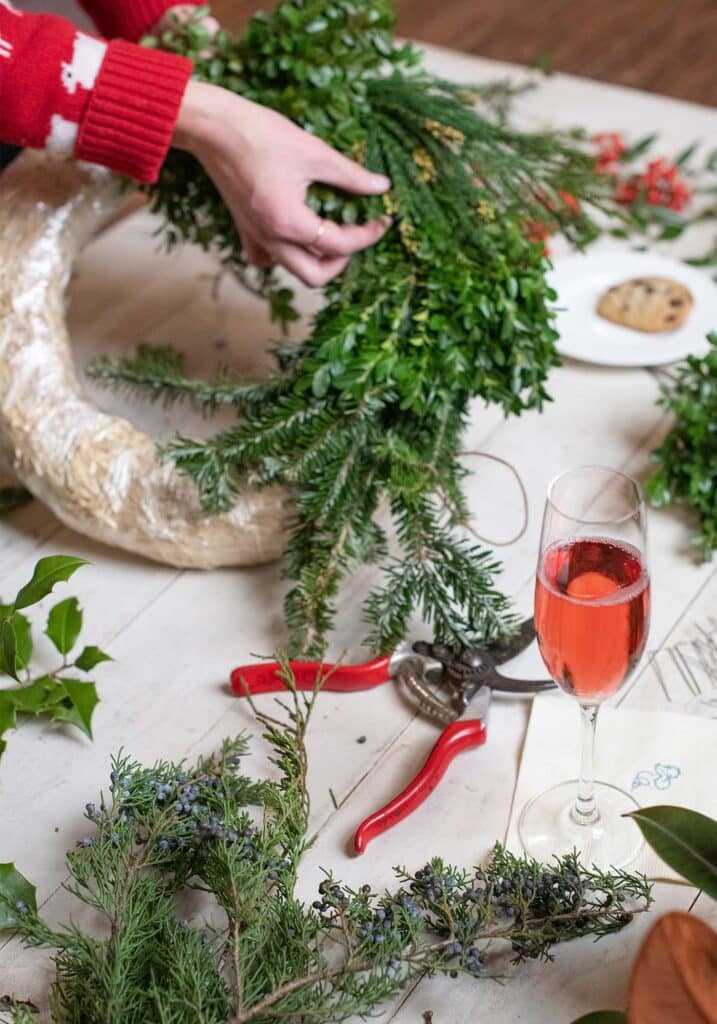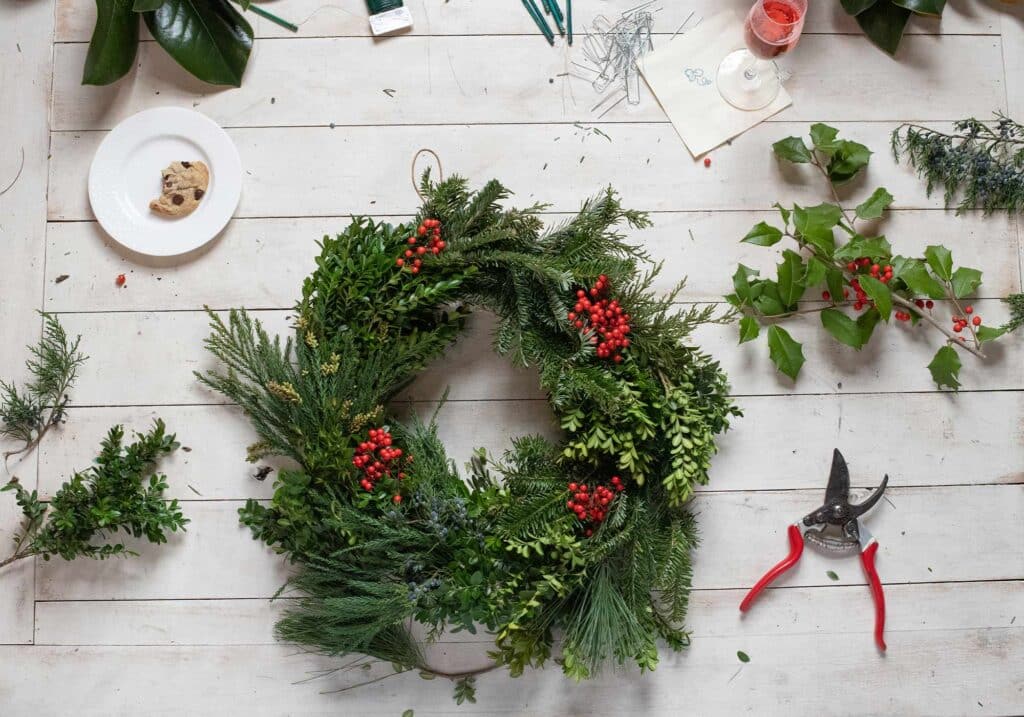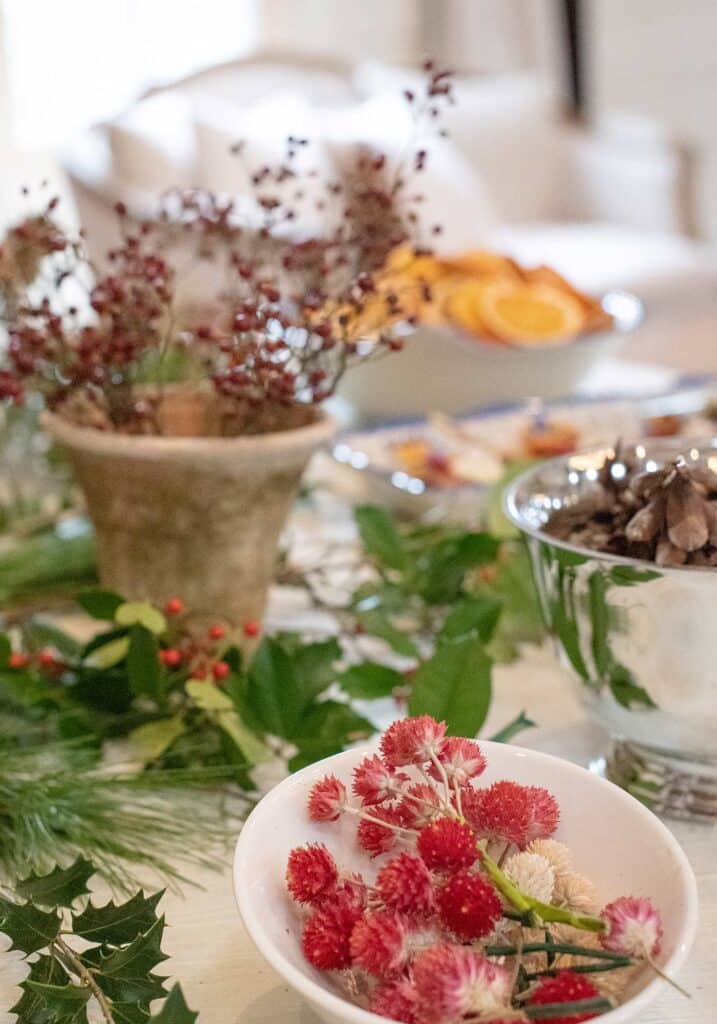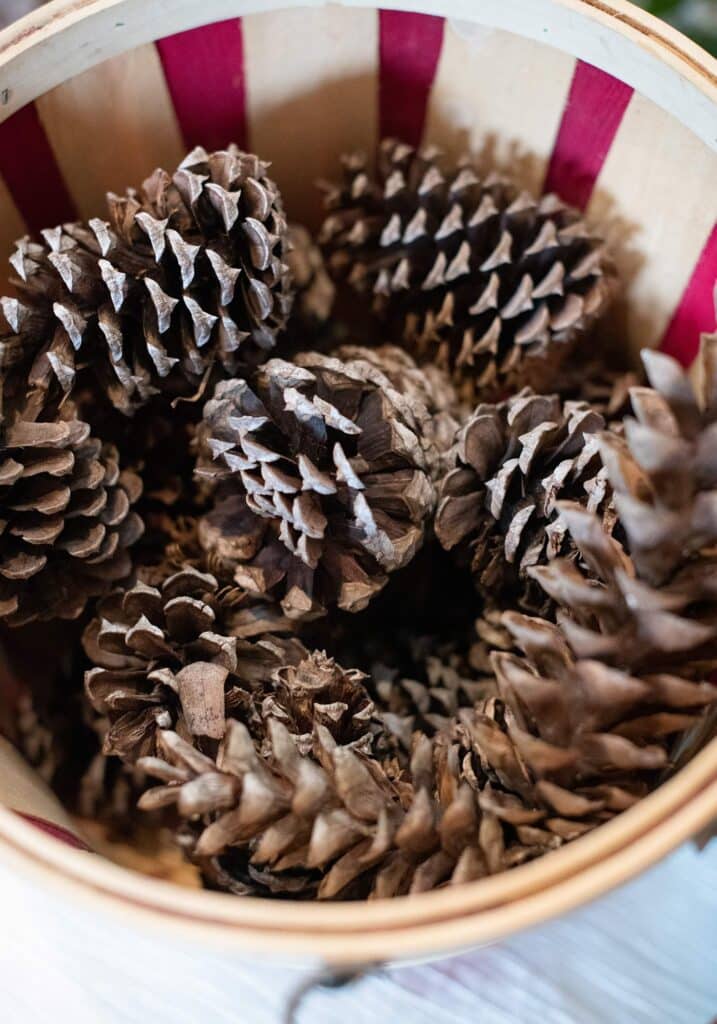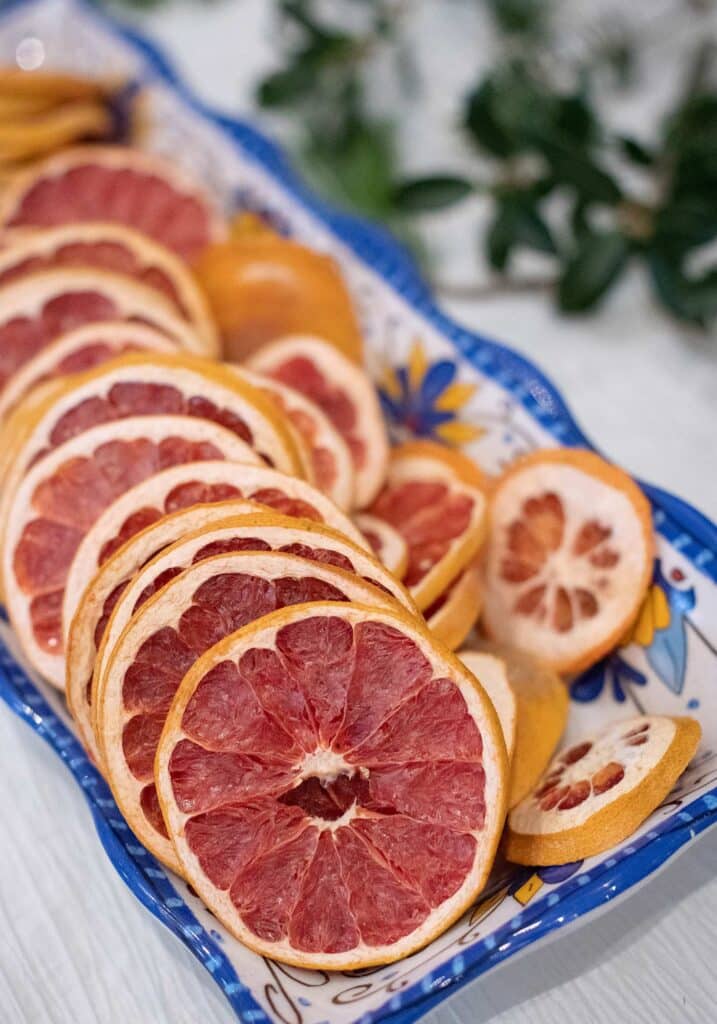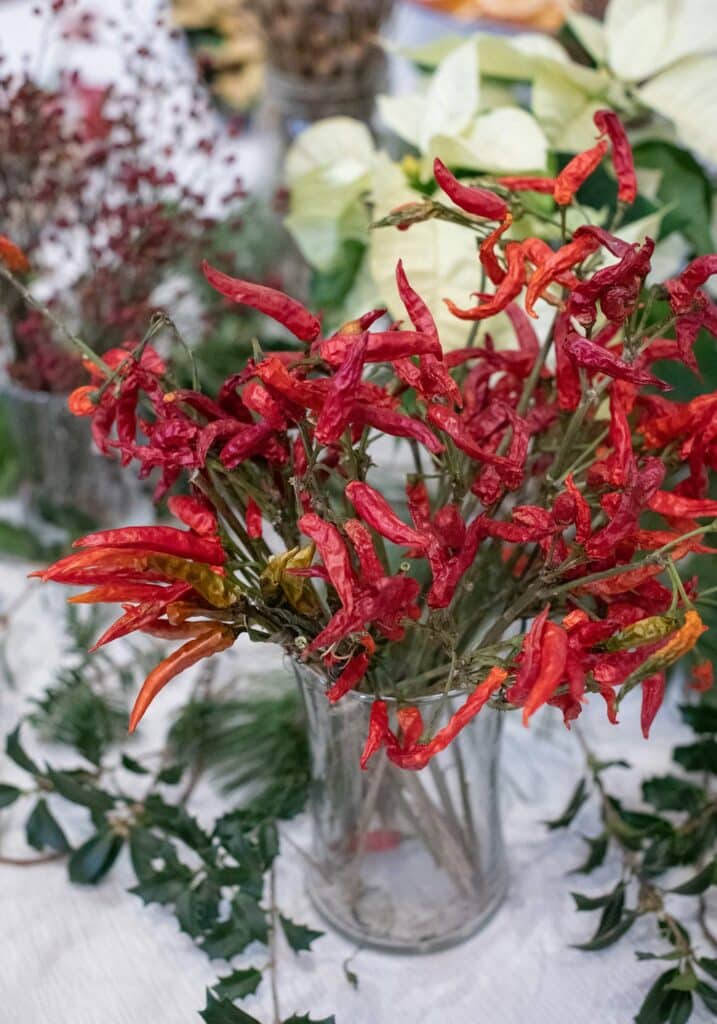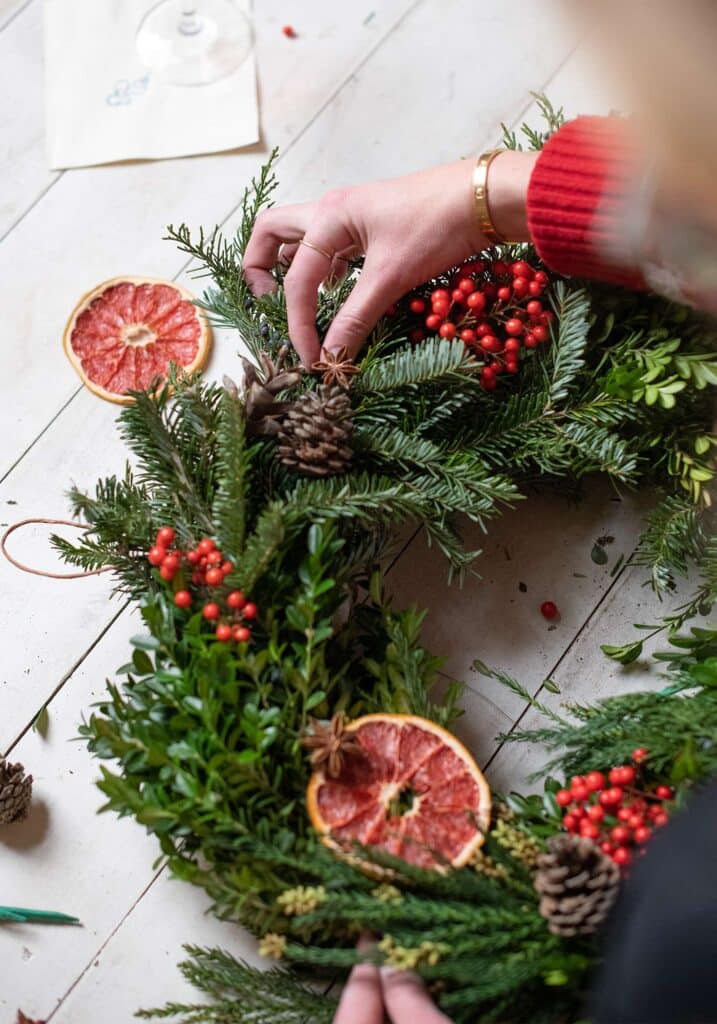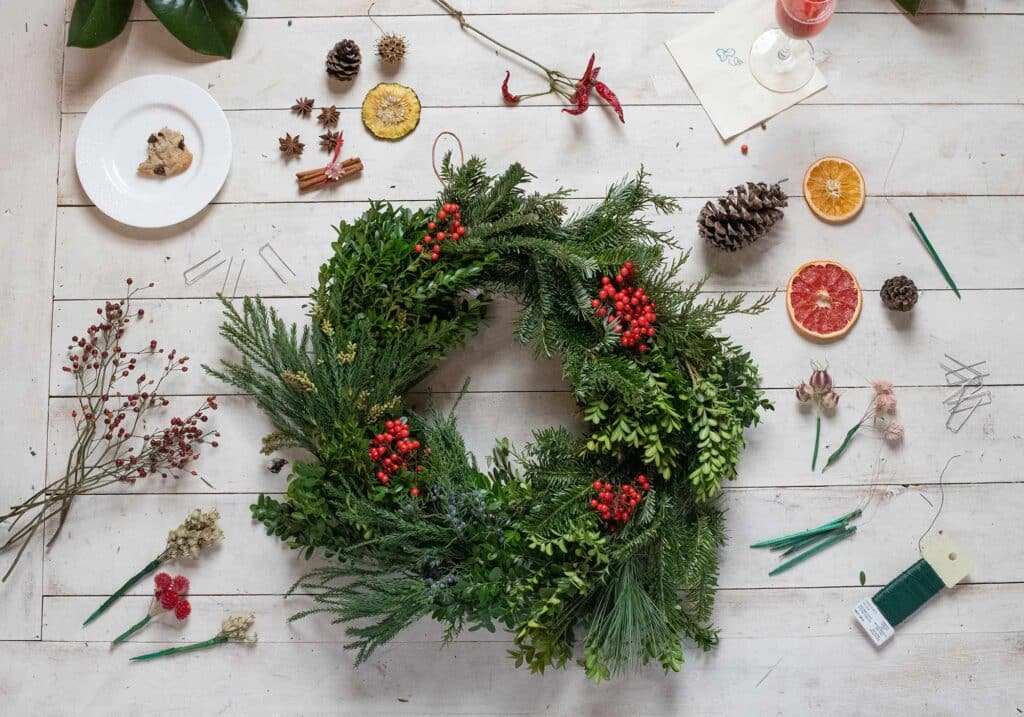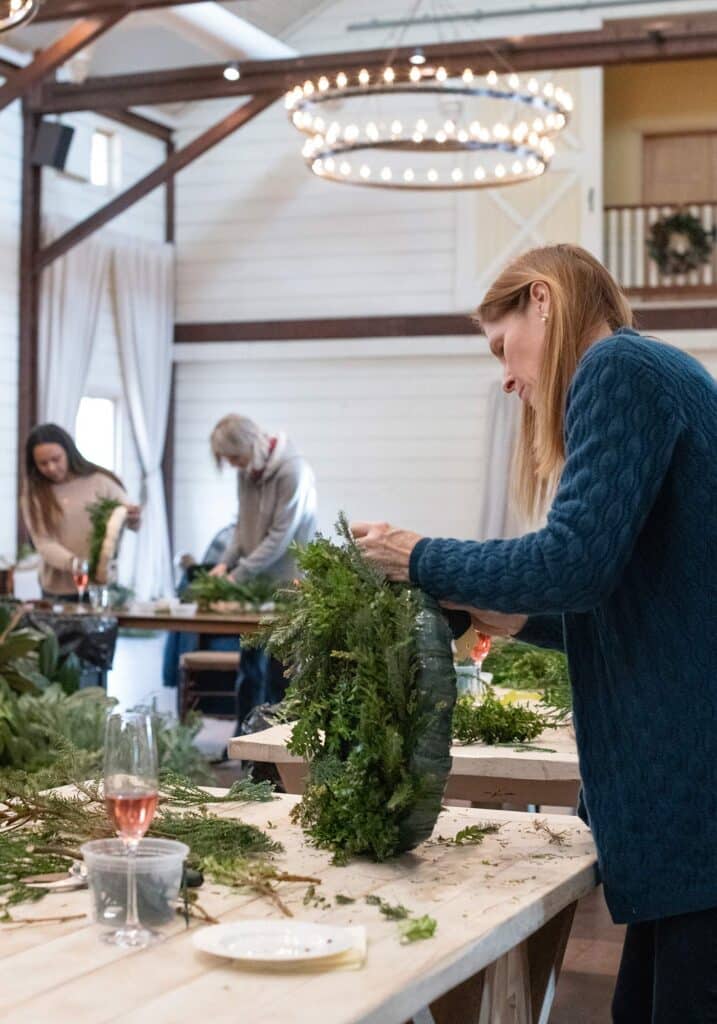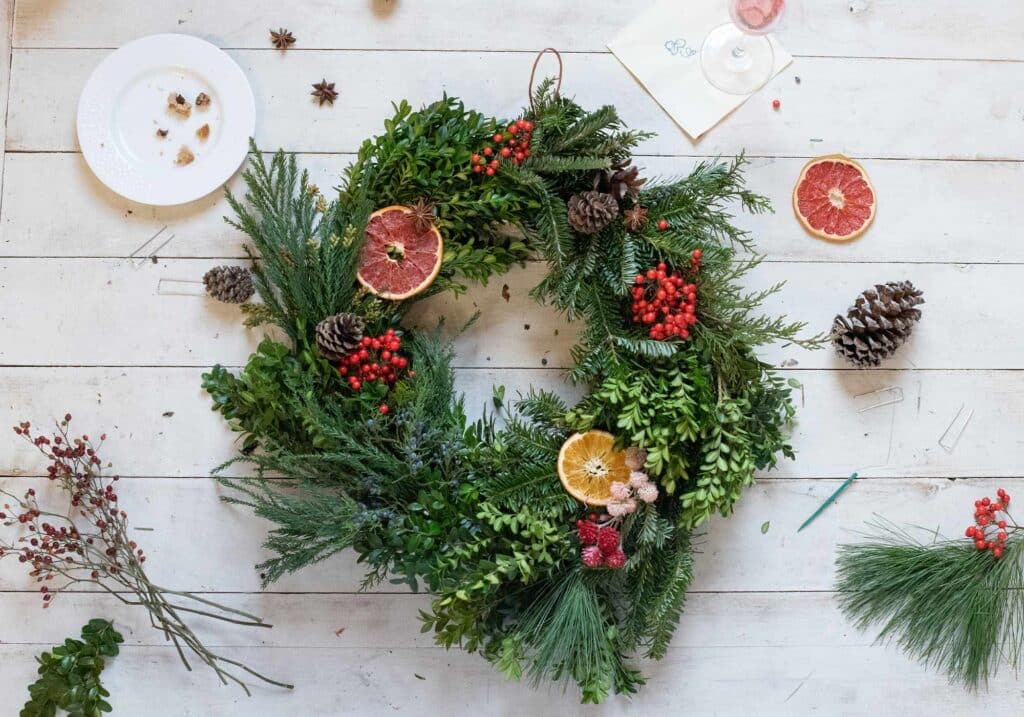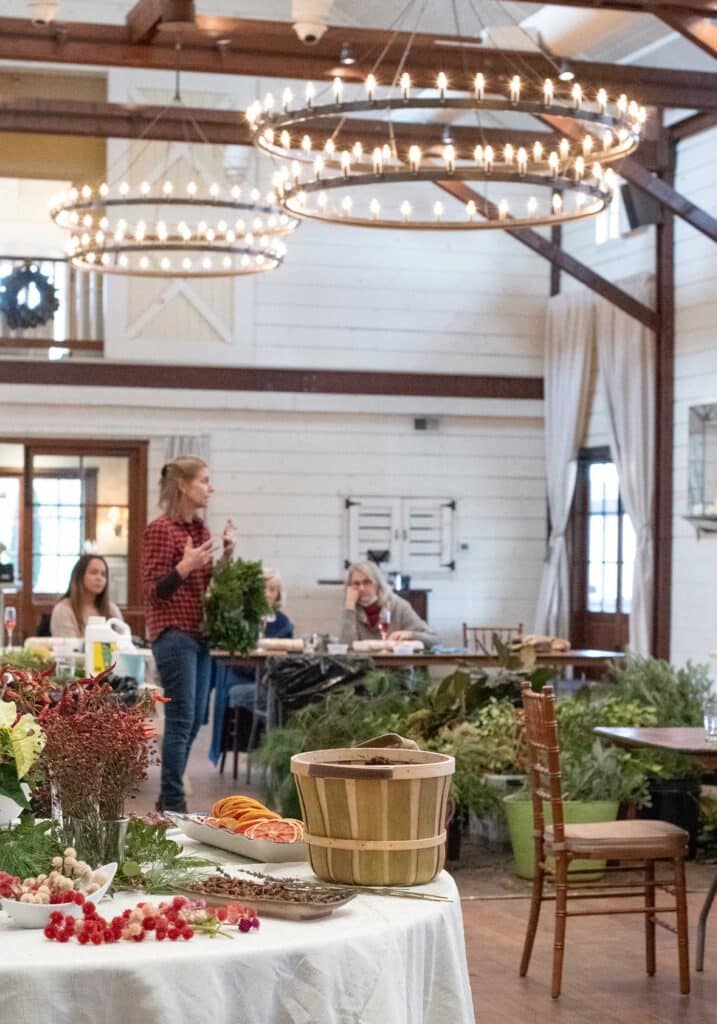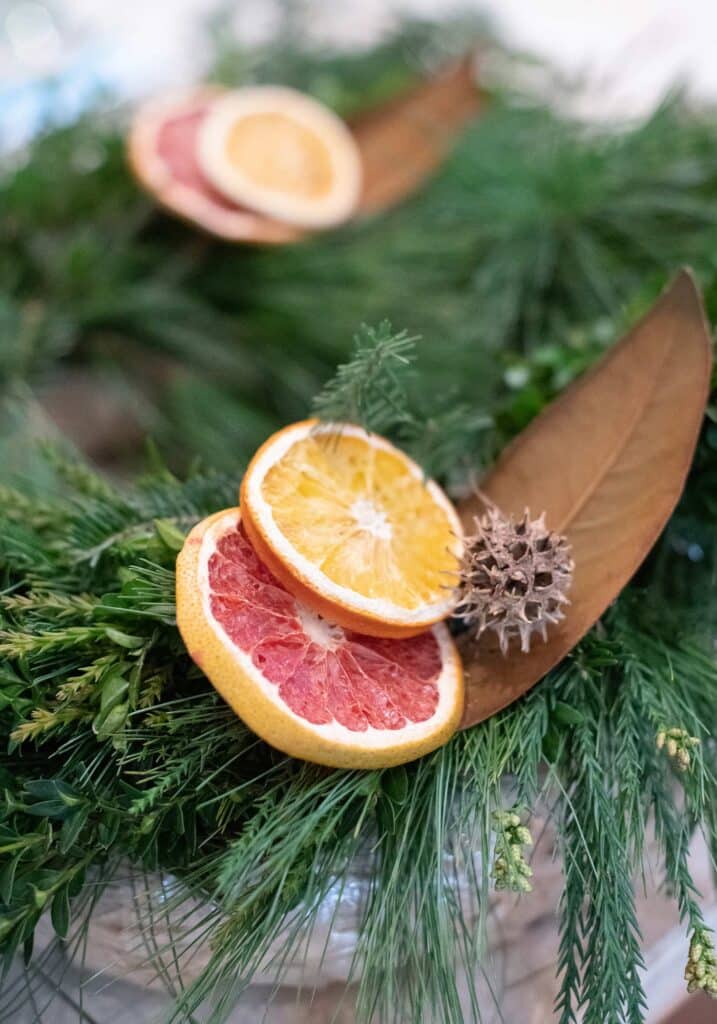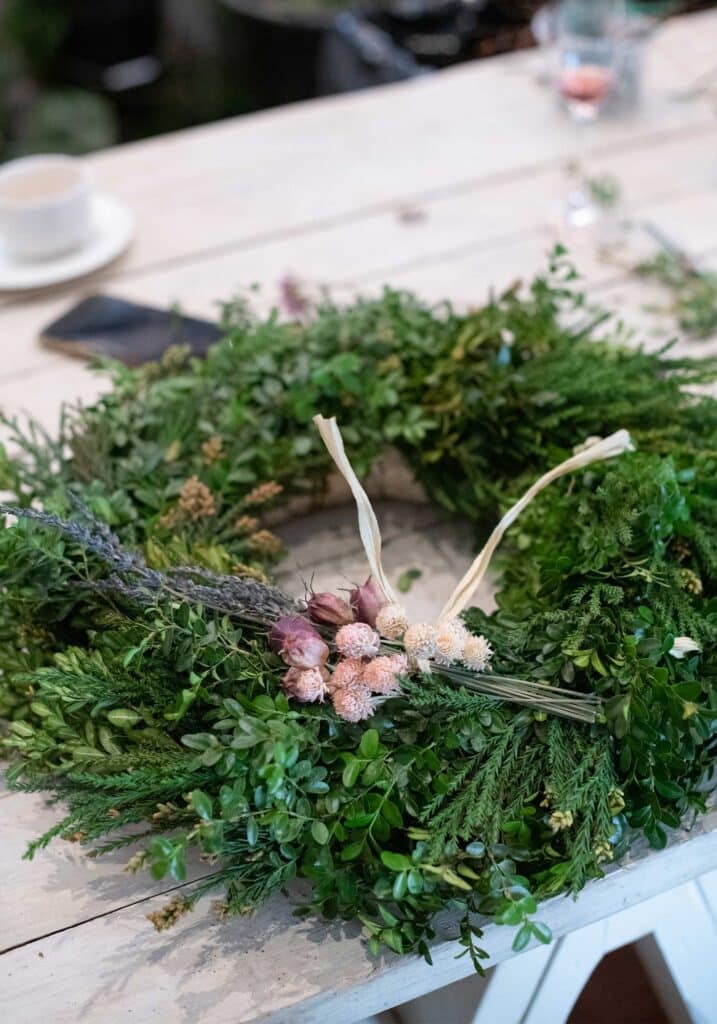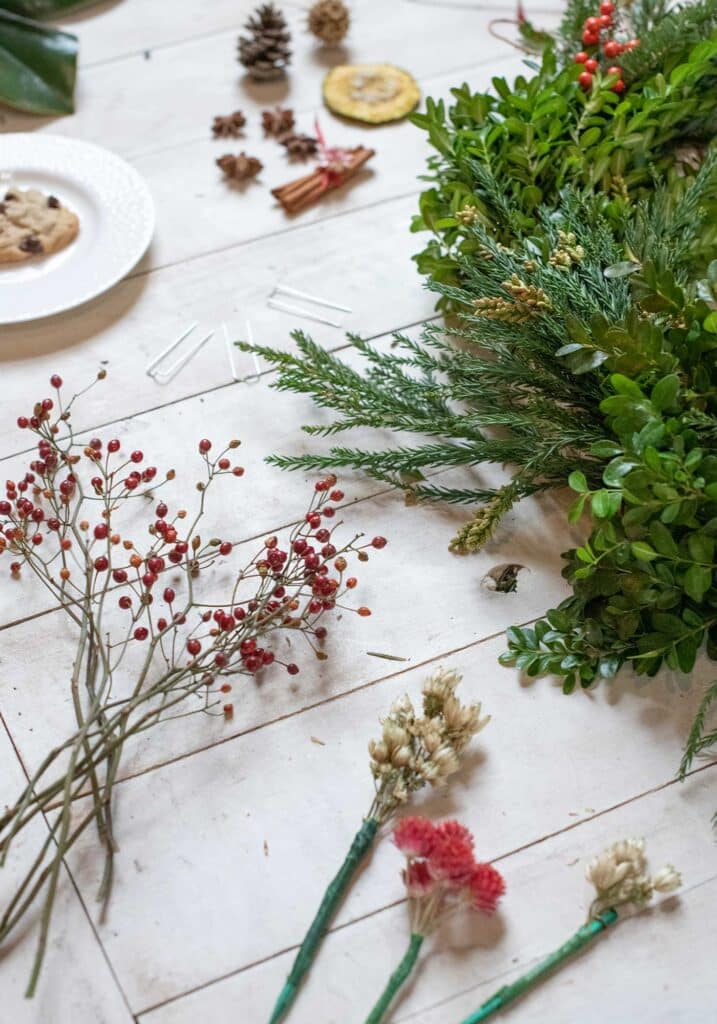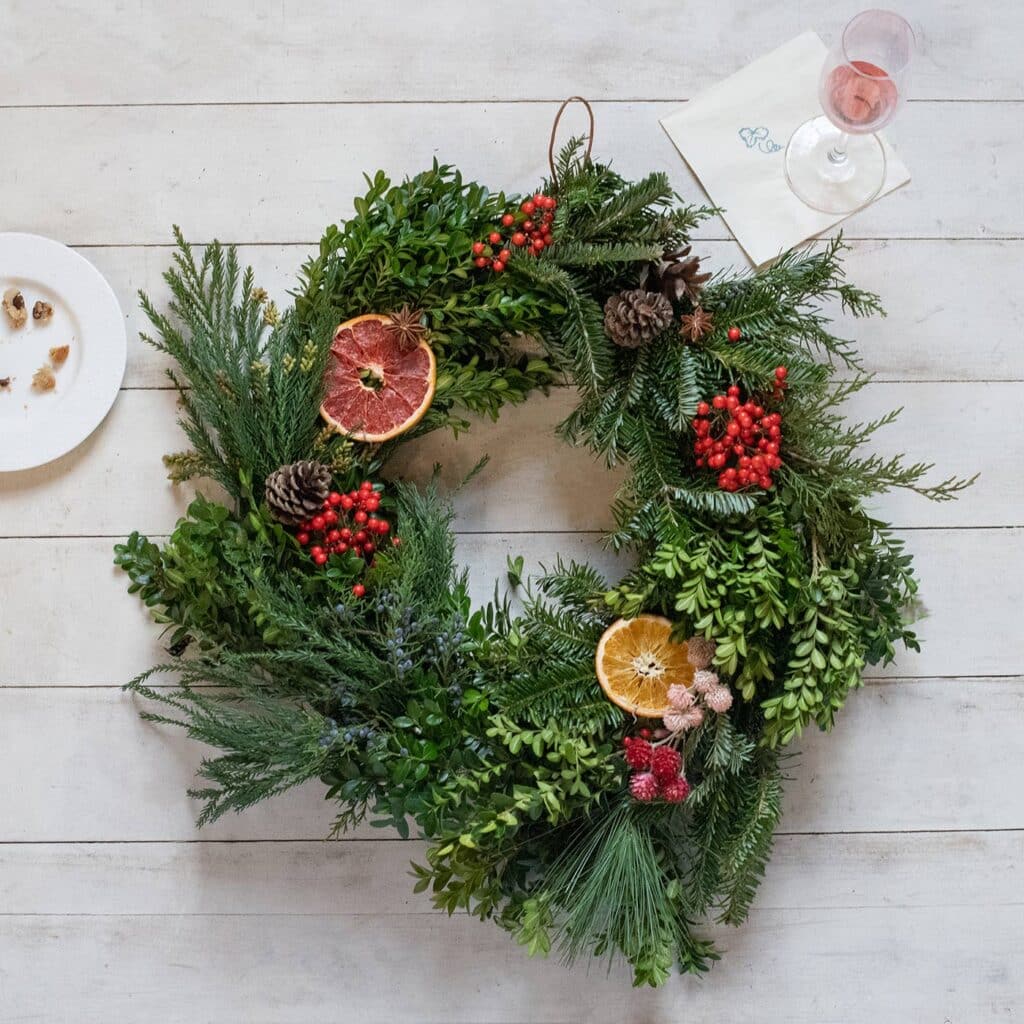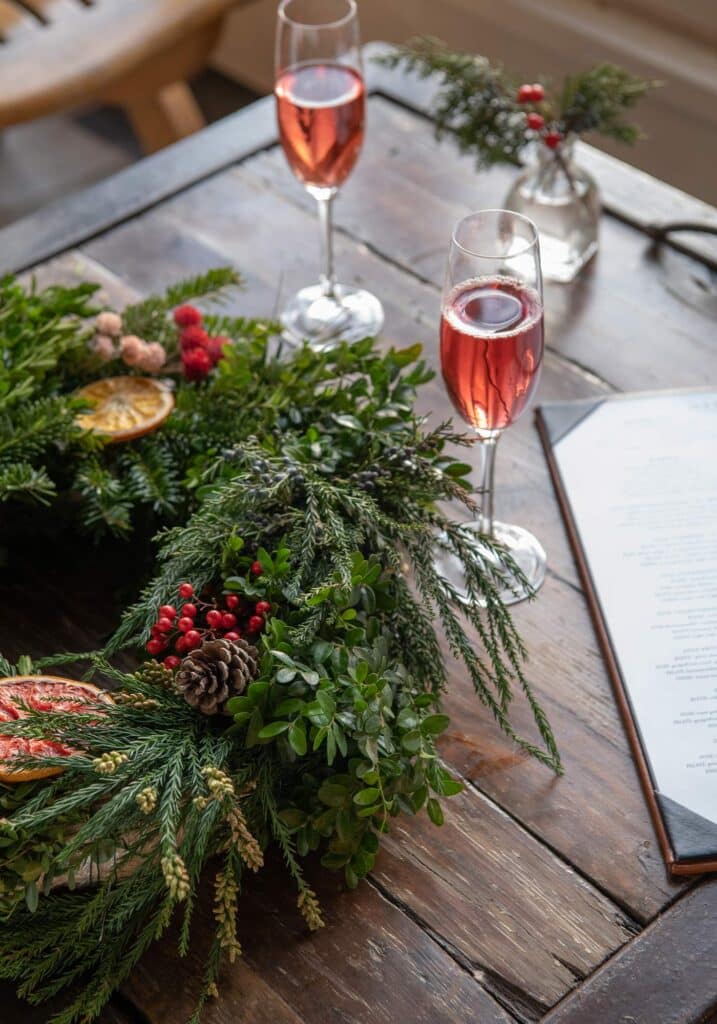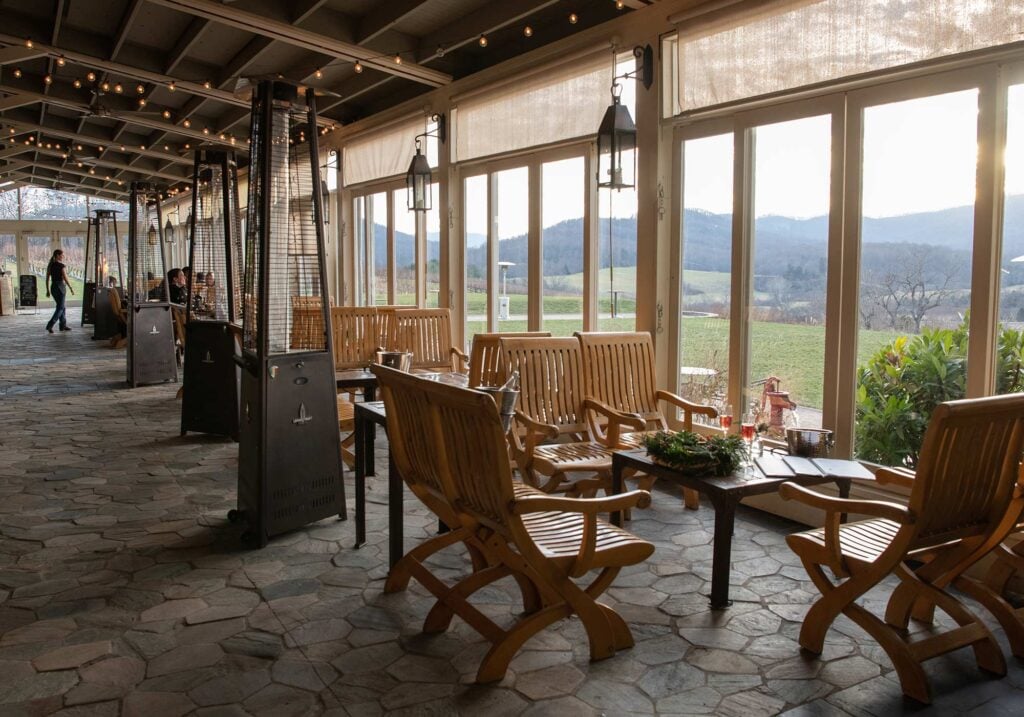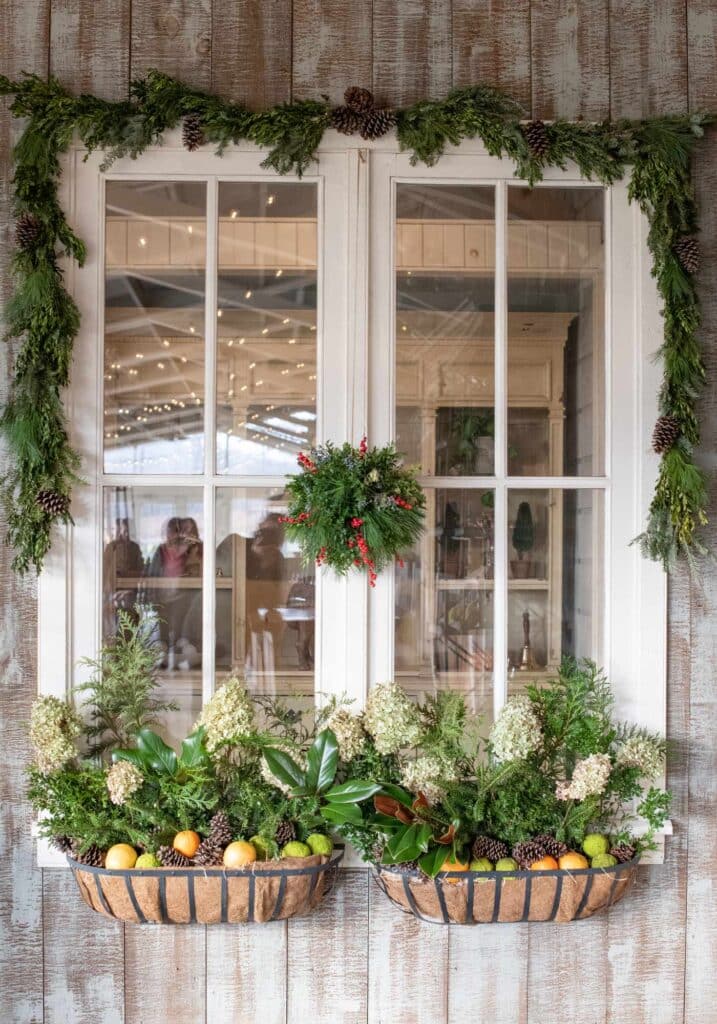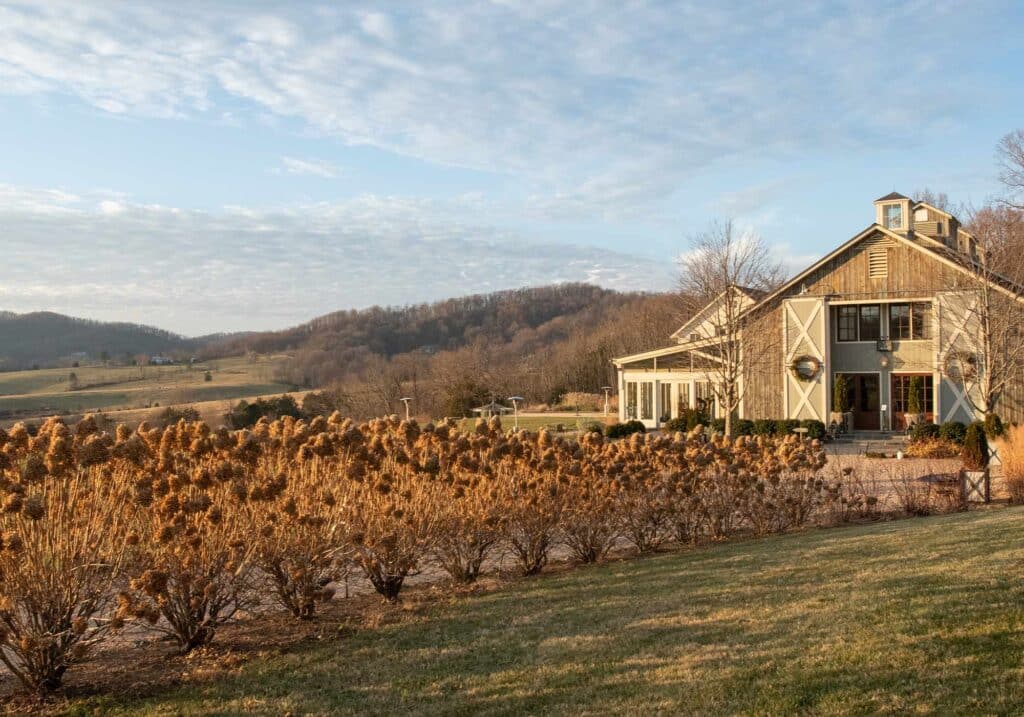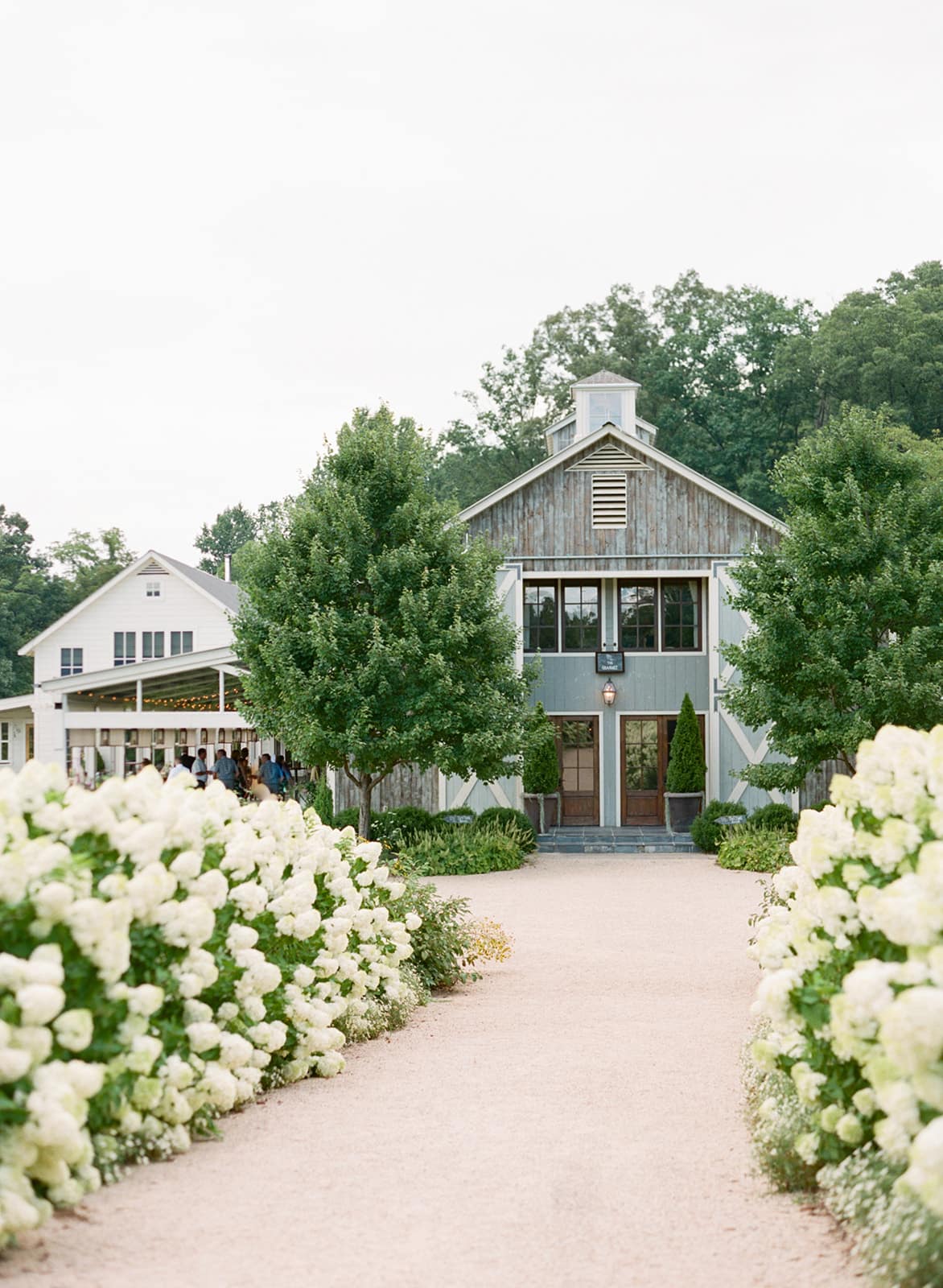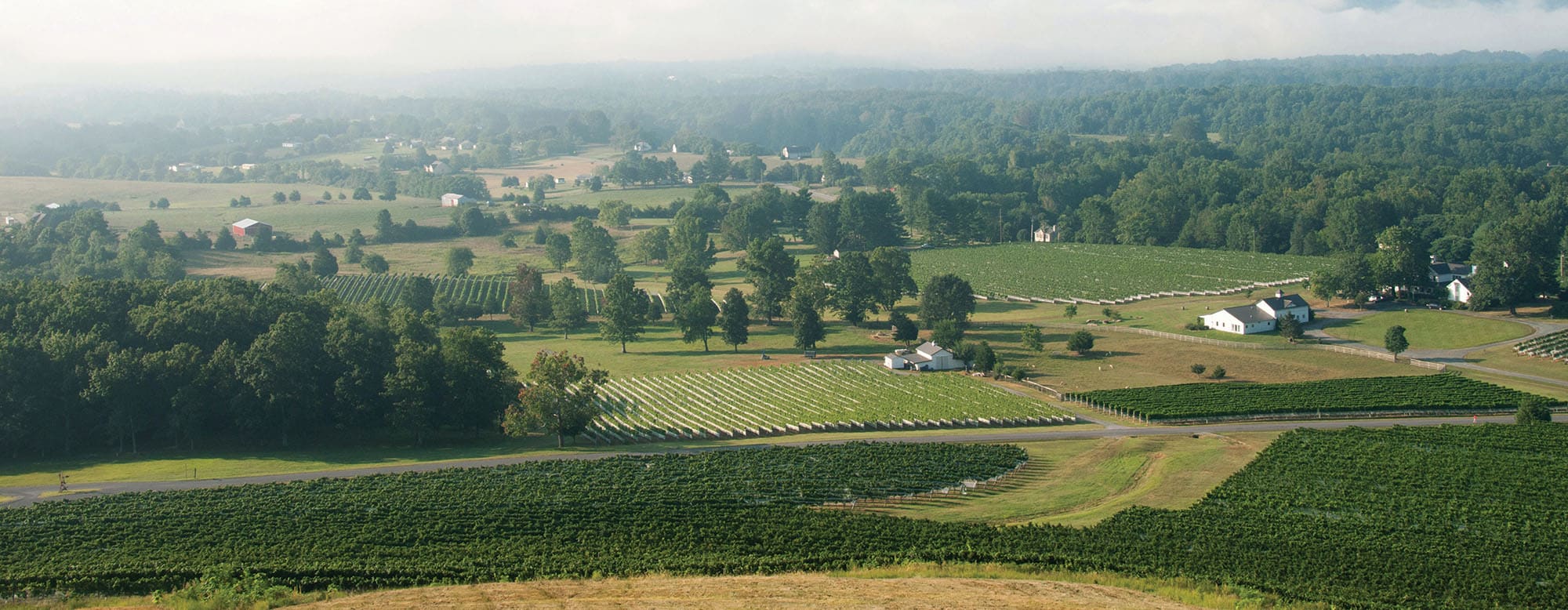Celine DeBrito, Head Gardener at Pippin Hill Farm & Vineyards, brings the garden into the winery’s granary every holiday season. Working alongside her team of assistants and master naturalists, DeBrito orchestrates a popular series of Holiday Wreath Making classes at Pippin Hill. This event has become a much-anticipated annual celebration centered around nature and holiday cheer, with a glass of wine on the side. Pippin Hill Farm & Vineyards is one of the most popular wineries near Charlottesville.
The annual Holiday Wreath Making Class is only offered a few times each December and early reservations are encouraged. Together, DeBrito and her team begin preparing for the event each January when they placed their seed orders for the kitchen gardens and the flower gardens on the property. When deciding which fruits, vegetables and flowers to grow, they were also asking “what would work well as dried fruits and flowers to embellish our holiday wreaths?”
We attended the beautiful workshop in 2021 under the leadership of former head gardener Diane Burns and brought back our notes for you including a wonderful tutorial on how to make your own beautiful Wine Country Wreath. Using items from your garden and nature you can create your own personal work of art to decorate your front porch this holiday season. Enjoy!
The carefully curated event was wonderful, and guests were treated to Pippin’s festive and beautifully balanced Sparkling Rosé by award-winning Winemaker Michael Shaps paired with house-made brownies and cookies by Chef Ian Rynecki. This Champagne-style Rosé blends together Cabernet Franc, Merlot and Chambourcin with a splash of Sauvignon Blanc, and features floral and fruity characteristics like raspberry and lavender on the nose and white peach and honeysuckle on the palate. Burns walked the attendees through the clippings that they worked with and the embellishments that were used to adorn the festive wreaths. The Southern Magnolia leaves from a staff member’s tree and the 80-year-old boxwood clippings from a neighbor made each wreath feel all the more personal and unique.
Pippin Hill once again invites attendees back this December for more delightful Holiday wreath-making this December. The event is truly unmissable.

Supplies to Make A Foraged Holiday Wreath
As Burns showed attendees, a wreath made from clippings from your own garden or in collaboration with elements from your friend’s backyard lends itself to a uniquely beautiful holiday wreath.
To get started, you will need the following:
- Wreath to Serve as the Base
- Brown / Rustic Wire
- Wooden Floral Picks
- Floral Tape
- Greenery
- Wilt Pruf (optional)
- Pruners (Burns Recommends Carbon Steel Pruners)
- Floral Wire / Paddle Wire
- Floral Pins / Greening Pins
- Hot Glue Gun
- Embellishments
How To Make A Wine Country Holiday Wreath
To create a hook or wreath hanger, select the brown or rustic wire and cut a roughly two-foot piece of it. Select the “top” of the wreath, the area from which the wreath will be hung, and create a loop that will comfortably fit over a wreath hook or nail on the door.
Loop the wire through the wreath and then wrap the excess around the loop to secure it, thus creating a secure loop from which you can hang your masterpiece once done.
For greenery, Fraser Fir clippings from your Christmas tree will work perfectly to create a traditional wreath. For the creatives, clippings from boxwoods, magnolia trees or cryptomeria (Japanese Cedar) all work beautifully to make a mixed wreath. Alternate Fraser Fir clippings with some or all of these options, or to create a completely new and unique wreath, choose different elements than the traditional Fraser Fir clippings.
Once you have selected your greenery, you want to begin attaching evergreens to the base. Select the paddle wire, evergreens and pruners from your tool kit. Clip the first bunch of greenery to measure roughly six inches (or the distance from the tip of your thumb to the end of your pinky when your hand is extended – the letter “Y” in sign language).
Next, put another bundle of greens on the wreath so that they overlay the previous bundle’s stems & wire. Only 2″-3″ of the tips of the previous bundles should be showing. Again, wrap this bundle of greens at the stems around the straw wreath. Continue this pattern until you have gone all the way around the wreath.
Burns suggests not to worry if there are holes or the greenery is not yet covering the entire area! Holes will be filled in using embellishments or additional greenery with floral pins. She also reminds us to make greenery clippings roughly the same length.
Working counterclockwise, repeat the process of creating greenery bundles from the clippings, then placing the next bunch on top of the floral wire before fanning the greenery out and wrapping the bundle around the base with floral wire.
The final greenery bundle will tuck underneath the tips of the first bundle to create a complete wreath! Clip away any excess or rogue stems, and then use the floral pins to fill in gaps with holly clippings, white pine or whichever clipping looks right.
Natural Materials to Decorate A Fresh Wreath
Once all of your bunches are placed and secured, you can focus on your adornments. Decide whether the wreath will have one focal point with decorative elements or if the wreath will incorporate a pattern or asymmetrical elements nestled amongst the leaves. There is no wrong answer! Personal taste and fancy should take over and guide the wreathmaker. Burns recommends first placing the selected embellishments on top of the wreath before committing to any design. This allows you to shift items and change your mind fluidly.
For greenery accents, try:
- Holly
- Juniper
- Nandina Berries
- White Pine
The holly and nandina berries offer pops of red that will embolden any wreath. Other natural elements can be:
- Pinecones
- Lavender
- Cinnamon Sticks
- Dried Fruit Slices
- Dried Flowers
Think beyond the ordinary and what says Virginia Wine Country. The Pippin Hill workshop featured dehydrated slices of orange and chili peppers, dried stems of globe amaranth, seed poppies, nigella, statice and straw flowers. Star anise, cinnamon sticks glued together, lavender and pinecones bring volume, texture and color to a wreath.
How to Attach Natural Elements to A Wreath
The dynamic and complex dried fruits and flowers can be a challenge to attach, but with the right tools and a patient hand, a wreath will transform into a splendor.
Delicate stems of dried flowers should be taped into small bouquets using floral tape before attempting to attach them to any wreath. The floral tape will protect the stems and give any wreath maker a more durable base to attach to the base.
Floral pins, wooden floral picks and a hot glue gun are the key to adding the finishing touches. For our wreath, we used floral pins to attach the dried oranges and then added star anise on top of the pin with a hot glue gun to conceal the pin.
Wooden floral picks worked wonders to attach the pinecone adornments. Simply weave the wire end of the pick through the bottom spines of the pinecone until secure, and then [stab] the wooden end of the pick into the straw base.
The delicate stems of the globe amaranth needed to be wrapped several times to protect the ends of the flowers, but once attendees created bundles, they were able to gently slide them amidst the boxwood. You may add a floral pin to ensure that they are secure.
Nandina berries have much more durable stems, so we could easily slip them into the greenery bunches without any floral tape.
Get creative and have Burns’s recommended tools, and your wreath will be one you want to douse in Wilt Pruf, an anti-transpirant that locks in essential moisture and protects your plants, so that it lasts all holiday season.
Foraged Holiday Wreath Ideas
Decorate your doors, mantels and more with your own natural wreath. Collecting natural elements doesn’t have to be limited based on your location. All you need is a little creativity and an open mind. Wreaths can be made of everything from grains and herbs to feathers and faux fur you’ve collected throughout Virginia Wine Country.
Try grouping together foraged leaves, branches and berries from your backyard or a friend’s yard. Magnolia leaves make a more modern look, but a new take could be painting some of the leaves silver and gold. Olive branches, birch bark, boxwood, evergreen and cedar branch are a few other ideas that would produce a classic wreath. Or, for an unfussy tone, moss and lichen-covered twigs would serve as a great base for a seasonal style.
In Virginia Wine Country, it would also be fitting to use a grapevine wreath base that is then livened up with a touch of foliage and pine cones. Another way to include elements from our farm-to-table region could be to combine staple herbs from your kitchen garden, such as sage, oregano, rosemary and bay leaves. No matter what style you feel like creating, there are plenty of natural elements to incorporate.
Relax in the Pippin Hill Tasting Room Veranda
After a day of wreathmaking, Pippin Hill’s vistas overlooking the countryside and the mountains offer the most idyllic end to any day. The typical blues and greens of the foothills deepen with hues of dark purple and golden brown during the winter. The changing colors of mid-winter make it feel as if it is always golden hour.
The veranda and indoor tasting area offer warm views that pair beautifully with a cheeseboard and a glass of the Sparkling Rosé that we were drinking during our wreathmaking class. Reservations, especially on the weekends, are always a good idea.
Pippin Hill is now also offering grab-and-go lawn seating, so guests can cozy up on the lawn by the fire pit with a grilled cheese and a glass of mulled wine or Cabernet Franc and enjoy the views by a fire pit.
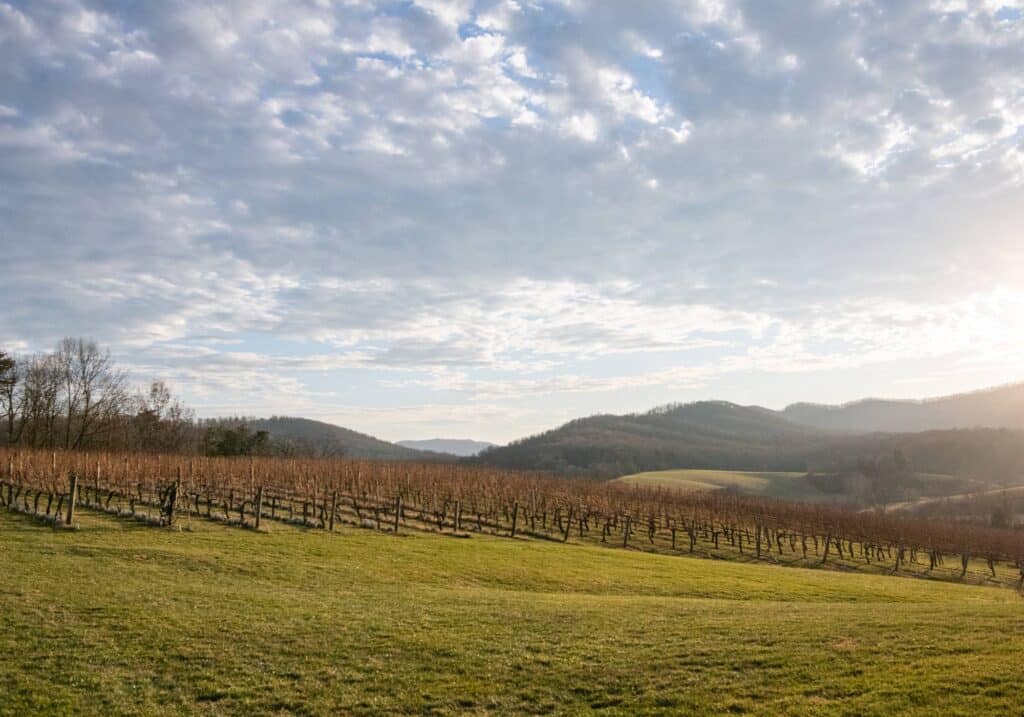
A Spectacular Winter Vineyard Landscape During the Holidays
This winter, Pippin Hill is also offering a series of classes that anyone from a culinary novice to a master chef would enjoy. This wreath-making class, in addition to these other upcoming classes, make a great holiday outing to enjoy with friends, family or a bridal party. In addition to their estate tours and tastings that are offered year-round, Pippin Hill hosts many farm-to-table workshops, including flower arranging.
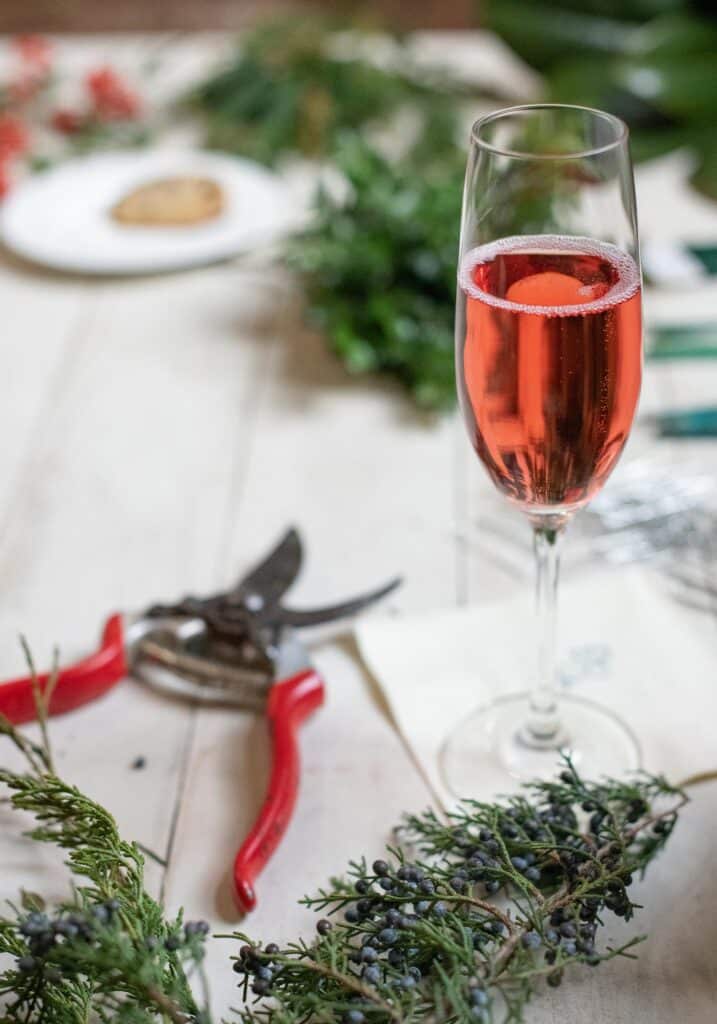
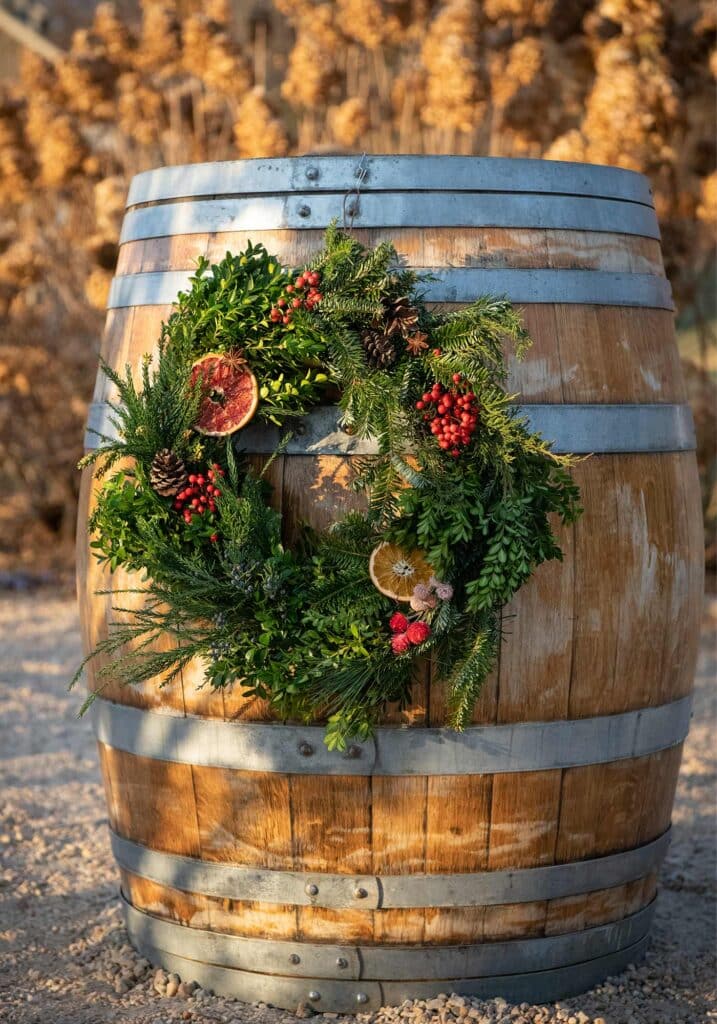
We hope this Holiday Wreath Making at Pippin Hill has inspired you to create your own dazzling wreath worthy of hanging in Virginia wine country. For even more holiday content, check out these delicious Winter Whiskey Recipes. Be sure to visit our Wine & Country Events Calendar for upcoming holiday and vineyard events. Still have some shopping to do? Browse our gift guides for quick and easy shopping suggestions.
For more from Pippin Hill Farm & Vineyards, see some recipes from their chef like Farm-to-Table Brunch Recipes, an Heirloom Tomato Salad, Made-from-Scratch Pizza and a Grilled Sea Bass Recipe, as well as A Farm-to-Table Dinner Celebrating the Equinox, Summer Entertaining Tips, Expert Tips on Flower Arranging and Treat & Charlotte’s Fall Vineyard Wedding. ~
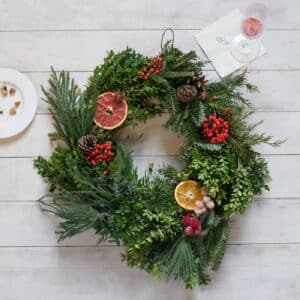
Holiday Wreath
Ingredients
- Wreath to Serve at the Base Diane Recommends a Straw Wreath
- Brown/Rustic Wire
- Wooden Floral Picks
- Floral Tape
- Greenery
- Wilt Pruf optional
- Pruners Diane Recommends Carbon Steel Pruners
- Floral Wire/Paddle Wire
- Floral Pins/Greening Pins
- Hot Glue Gun
- Embellishments
- Gardening Sheers
Instructions
Step One: Create a Wreath Hanger
- To create a hook or wreath hanger, select the brown or rustic wire and cut a roughly 2-foot piece of it. Select the "top" of the wreath, the area from which the wreath will be hung. Create a loop that will comfortably fit over a wreath hook or nail on the door.
- Loops the wire through the wreath and then wrap the excess around the loop to secure the loop, thus creating a secure loop from which you can hang your masterpiece at the end.
Step Two: Attach Evergreens to the Base
- Select the paddle wire, evergreens, and pruners from your tool kit. Clip the first bunch of greenery to measure roughly 6 inches (or the distance from the tip of your thumb to the end of your pinky when your hand is extended – “Y” in sign language).
- Fan the greenery bunch around the straw wreath base with one hand and use the other hand to wrap the grenery bunch around the base using the floral wire. Wrap the floral wire around the greenery and straw wreath, pulling taught, roughly three or four times. Clip the paddle wire and secure the wire to itself.
- Diane's Tips:* Don't worry if there are holes or the greenery is not yet covering the entire area! Holes will be filled in using embellishments or additional greenery with floral pins.* Make greenery clippings roughly the same length.
Step Three: Repeat
- Working counterclockwise, repeat Step Two: Create greenery bundles from the clippings, place the next bunch on top of the floral wire, fan the greenery out, and wrap the bundle around the base with floral wire.
- The final greenery bundle will tuck underneath the tips of the first bundle to create a complete wreath!
- Clip away any excess or rogue stems and then use the floral pins to fill in gaps with holly clippings, white pine, or whichever clipping looks right.
Step Four: Decorate
- Select pinecones, cinnamon sticks, and dried fruit slices to adorn the wreath. Decide whether the wreath will have one focal point with decorative elements or if the wreath will incorporate a pattern or asymmetrical elements nestled amongst the leaves. There is no right answer! Personal taste and fancy should take over the guide the wreathmaker.
- Diane's Tips:* Place the selected embellishments on top of the wreath ahead of time before committing to any design!
ABBY MEREDITH ARMISTEAD is a Double Hoo who loves all things Charlottesville and equestrian. Abby grew up competing through the Arabian Horse Association, where she found success as a four-time Youth National Champion. During college, Abby made the switch to Hunter Jumpers and competed throughout Virginia. Abby worked as an attorney in Washington, D.C. and now is a freelance writer living in Charlottesville, where she spends her weekends hiking with her dog in the Blue Ridge Mountains, frequenting the farmers market and reading any novel she can get her hands on.
R. L. JOHNSON is our co-publisher and creative director, Robin Johnson Bethke, who began her career as a professional photographer in Los Angeles before moving into graphic design and art direction when she relocated to Charlottesville in 1994. As our company’s co-founder and visionary, she enjoys all aspects of the publishing process from story conception to graphic design to photography. Her work is often seen in many of our publications.


